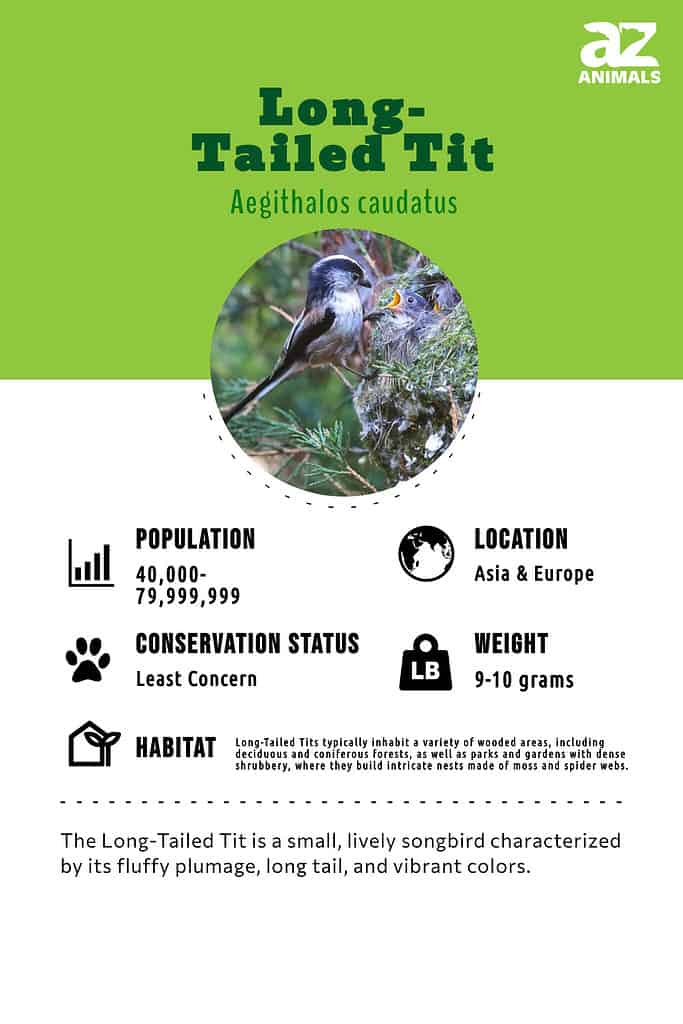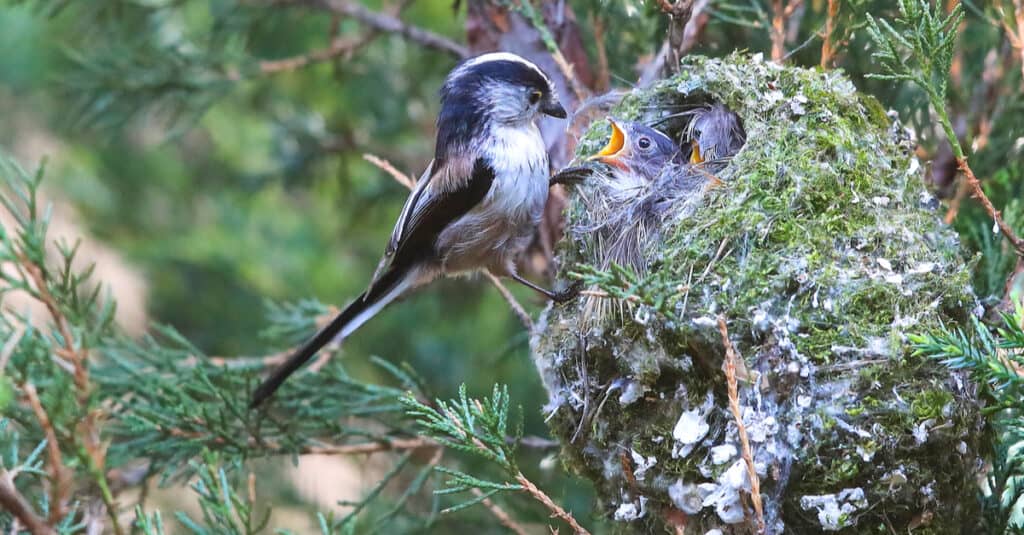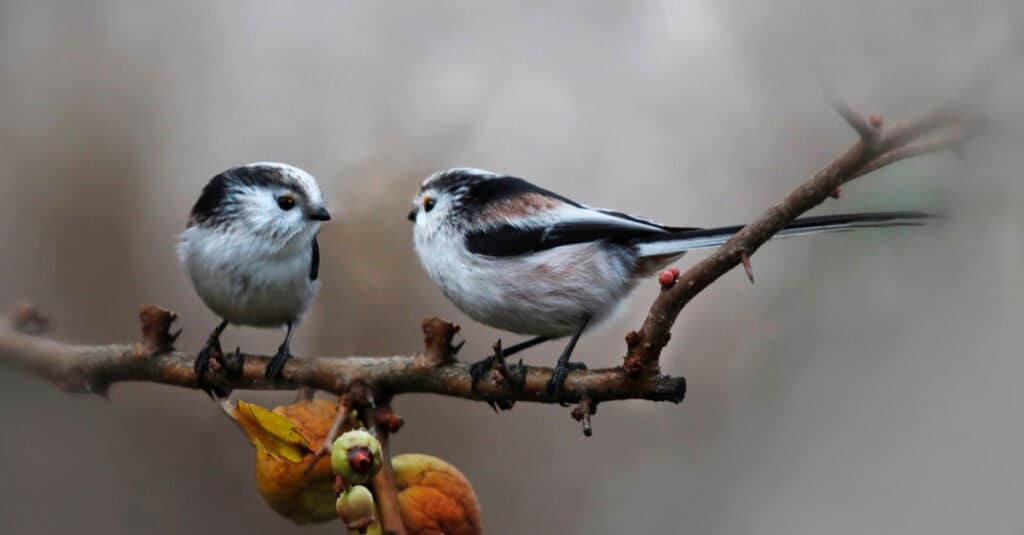Long-Tailed Tit
Aegithalos caudatus
Often hangs upside down while feeding!
Advertisement
Long-Tailed Tit Scientific Classification
- Kingdom
- Animalia
- Phylum
- Chordata
- Class
- Aves
- Order
- Passeriformes
- Family
- Aegithalidae
- Genus
- Aegithalos
- Scientific Name
- Aegithalos caudatus
Read our Complete Guide to Classification of Animals.
Long-Tailed Tit Conservation Status
Long-Tailed Tit Facts
- Prey
- Insects
- Fun Fact
- Often hangs upside down while feeding!
- Biggest Threat
- Freezing weather, predators
- Most Distinctive Feature
- Extremely long tail
- Other Name(s)
- Alpine tit, European tit
- Wingspan
- 5.5 inches
- Incubation Period
- 13-17 days
- Litter Size
- 6-15
- Habitat
- Moorlands, farmlands, town and city gardens
- Predators
- Falcons, jays, crows
- Diet
- Omnivore
- Type
- bird
- Common Name
- Long-tailed tit
- Number Of Species
- 17
- Location
- Asia and Europe
- Average Clutch Size
- 10
- Nesting Location
- Fork of a tree branch
- Age of Molting
- 14-18 days
View all of the Long-Tailed Tit images!

“Often hangs upside down while feeding!”
Long-tailed tits are frequent visitors to gardens and parks in the United Kingdom, where they are abundant. These small, fluffy birds welcome visitors with their adorable looks and sweet, cheerful songs. The chief identification marks are their round bodies and white plumage. Most long-tailed tits also have pale pink or lilac on their breasts and wings. They are insectivores who don’t migrate in the winter.
Where To Find Long-Tailed Tits

Long-tailed tits predominantly inhabit the United Kingdom, occupying various regions except for the coldest areas in the northern parts of Scotland.
©Chosg/Shutterstock.com
Long-tailed tits primarily live in the United Kingdom, where they live everywhere except the coldest northern parts of Scotland. Their range extends across Europe and into Japan and China. They inhabit farmland, heathland, moorland, and wetlands. In recent years, their preferred habitat has become towns and cities, where they often visit hedgerows, suburban gardens, and city parks.
They are not migratory. In the winter, they form large flocks that include other tit species.
In 2020, long-tailed tits were listed among the top 10 most spotted garden birds in the United Kingdom, with a recorded appearance of more than 37% since 2010. A mild winter and the widespread use of backyard bird feeders have contributed to this population increase.
Evolution and Origins
Out of the seven species, five inhabit the Himalayas or mountainous regions of western China. The long-tailed tit is the most widespread species, spanning across Western Europe and Asia, reaching as far as China and Japan. On the other hand, the pygmy tit is the most geographically limited, found exclusively on the island of Java.
The long-tailed tit is found in many parts of Northern Europe and the Palearctic region, including Scandinavia and the Mediterranean zone. It lives in woodlands with shrubs, as well as scrublands, heathlands, farmland, and even parks and gardens.
How to see long-tailed tits
They are friendly birds who will eat seeds, especially in the winter when their preferred food is scarce. Bird lovers can easily attract them to a backyard habitat. Use clean, well-kept feeders stocked with crushed peanuts and sunflower seeds. They are enjoyable to watch because they will flit from tree to tree and sometimes hang upside down to feed.
Because they build dense, warm nests, it is also a clever idea to put out nesting materials in the spring. They can use feathers, grass clippings, dead leaves, and moss.
Scientific name
The long-tailed tit’s scientific name is Aegithalos caudatus.
The tit family, Paridae, has 46 species of small birds, which are known as tits, titmice, and chickadees. They are small songbirds of the order Passeriformes. They live in forests, shrubby woodlands, urban parks, and suburban gardens.
In Europe, the long-tailed tit is sometimes called the European tit or alpine tit. Other names for this bird are the long-tailed pie, mumruffin, bottle tit, bum barrel, bum towel, ovenbird, and hedge jug.
Appearance
The long-tailed tit is a small, fluffy bird with a black cap, white-collar and black-and-white feathers. Their chief identification markers are their round bodies, long tails, and soft pink or lilac feathers.
Identification of many tits can be confusing because many tit birds look alike. However, identification of the long-tailed tit is easier than it is for other members of the family because of this bird’s long tail and pink colors.
True to its name, this bird has a tail that is longer than its body. It has distinct black stripes around its eyes. The pink colors can extend to its entire breast and wing. Males and females look alike and have the same colors. It is a small bird with a length of six inches, including its long tail, and a wingspan of 5.5 inches. It weighs about .35 an ounce.

The long-tailed tit is a small avian species characterized by its fluffy appearance, featuring a black cap, a white collar, and black-and-white feathers.
©R. Maximiliane/Shutterstock.com
Behavior
These birds are active in the daytime. They begin hunting in the morning, and they spend the day catching small insects to eat. At dusk, they return to their roosts or nests.
Long-tailed tits are not migratory, and this makes them susceptible to harsh winters. When chilly weather arrives, they form flocks of birds that nest and huddle together on tree branches. Some of these groups have six to 10 members, but they can sometimes have 20 to 50.
These mixed flocks often include other members of the titmouse and chickadee families. They do this to keep warm. These small birds lose a lot of energy hunting all day, and they huddle together to share their body heat.
In the spring, the groups break up and the birds go off on their own to mate, build nests and rear their young. They are known for the extensive hovering they do in search of the perfect nesting site. They will fly in a vertical motion as they spot a good place to call home.
Migration Pattern and Timing
Long-tailed tits do not migrate, and cold temperatures are one of the chief threats to their survival. A particularly harsh winter can cause many long-tailed tit deaths. They make up for this loss by increasing the number of eggs they produce, and this has kept their population stable.
Song
The long-tailed tit has a particularly pretty song. It is high-pitched and sweet, and it is punctuated by frequent purring notes that sound like, “Prrt, prrt, prrt.”
Diet
The long-tailed tit is an omnivore that mostly eats insects.
What does the long-tailed tit eat?
It eats the eggs and larvae of moths and butterflies. It will also eat spiders and aphids. In the autumn and winter, it supplements its diet with a range of seeds.
Predators and Threats
Long-tailed tits are extremely sensitive to extreme cold, and many do not survive a harsh winter. They make up for this by increased breeding.
Their chief predators are bluejays and crows, who attack titmouse nests to eat their chicks. The nests of long-tailed tits have a high predation rate. Falcons sometimes eat adult long-tailed tits.
Reproduction, Babies, and Lifespan
When the winter flock breaks up, a male long-tailed tit will mate with a female from the same flock. They immediately begin looking for a nesting site and building the nest. They don’t have a wide range and stay close to their roosting spot.
After mating, the female lays her eggs in the nest. A long-tailed tit can lay from six to 15 eggs but typically will lay eight to 12. The eggs are small and have reddish spots. After 13 to 17 days, the eggs hatch. Both the parents and some helper birds share feeding duties. The chicks become fledglings after 18 days. They are ready to fly on their own for about three months. These birds typically live two to three years in the wild.
Nest
The long-tailed tit builds its nest in the fork of a tree. The nest is oval, and both parents help build it. They start building in February and spend about three weeks constructing it. A long-tailed tit nest has many layers, and the birds use moss, hair, spiderwebs, feathers, and lichens. They may use up to 2000 feathers to line it. They use moss to hide the nest from predators.
It is common for long-tailed tits to invite other birds to help them raise and feed their chicks. These babysitting birds are usually related to the residents, and some are birds who have lost their babies to predators. They also help protect the nest from predators. Males and females can be nest sitters.
Population
The exact population of long-tailed tits is not known, but the British Trust for Ornithology (BTO) estimates there are 340,000 breeding territories in the United Kingdom. The population is considered stable, and long-tailed tits are among the few birds whose population in the United Kingdom has grown in recent years.
Conservation Status
The International Union for the Conservation of Nature (IUCN), BirdLife International, and the BTO all list the long-tailed tit as a “species of least concern.’ Its population is considered stable and reasonably abundant.
Popular Backyard Birds
Long-tailed tits are lovely birds that help control insect populations. Their popularity among backyard garden feeders has helped them thrive despite predators and harsh winters. Conservation efforts will benefit all birds and ensure we can enjoy them for many years.
View all 98 animals that start with LLong-Tailed Tit FAQs (Frequently Asked Questions)
Where do long-tailed tits come from?
This bird is native to Asia, Europe, and the U.K.
Where can I buy a long-tailed tit?
You can’t. It is a wild bird, and it is illegal to own one.
Is a wagtail the same as a long-tailed tit?
No, but it also has a long tail. The white wagtail (Motacilla alba) is a slender, black and white bird. It is the national bird of Latvia.
What's a group of Long-tailed Tits called?
It is called a flock. A group of chickadees, which are members of the tit family, are known as banditry.
Is there any symbolism attached to the long-tailed tit?
There is no specific symbolism attached to it. The long-tailed tit is a member of the chickadee family, and chickadees are a symbol of good luck in many cultures. In Plains Indian mythology, it is regarded as good luck to see a titmouse or chickadee in a dream. In Tarot symbolism, a titmouse means it’s time to change old habits.
Thank you for reading! Have some feedback for us? Contact the AZ Animals editorial team.
Sources
- BTO, Available here: https://www.bto.org/understanding-birds/species-focus/long-tailed-tit
- BirdSpot, Available here: https://www.birdspot.co.uk/a-little-bird/news/long-tailed-tits-fly-into-the-top-ten-in-the-2020-big-garden-birdwatch
- rspb, Available here: https://www.rspb.org.uk/birds-and-wildlife/wildlife-guides/birdwatching/how-to-identify-birds/the-great-tit-confusion
- Bird Watching, Available here: https://www.birdwatching.co.uk/features/species/long-tailed-tit/

















